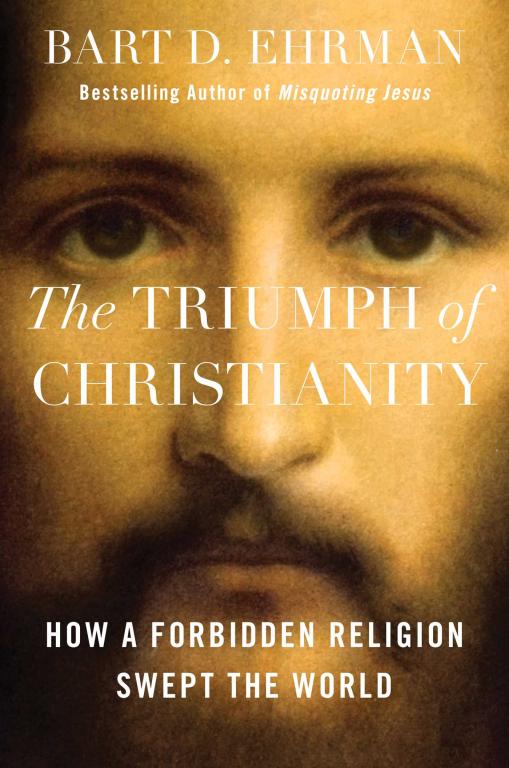I recently finished the religion scholar Bart Ehrman’s latest book titled The Triumph of Christianity: How a Forbidden Religion Swept the World in which he explores the early history of how Christianity began to grow into what it is today: the world’s largest religion with more than 2 billion adherents. (For anyone wondering, the Hindu Tradition is the third largest at 900 million. And projections estimate that Islam, currently in second place, will become the world’s largest religion by 2070.)
If we turn back the clock a little more than two millennia, it is interesting to consider the unexpected turn of events in the wake of Jesus’s death: “before four centuries had passed, twenty or so lower-class, illiterate Jews from rural Galilee had become a church of some thirty million” (7). How did that happen?
One traditional answer to this question is that this exponential rate of growth is proof of divine blessing. This type of explanation is problematic for quite a few reasons. If you attribute seemingly good things in your life to a higher power smiling upon you, then do you also consistently attribute the bad things in life to a high power punishing you? Furthermore, it’s far from clear that the brand of Christianity that became popular in the Roman Empire—or the denominations that are most popular in the world today—have much to do with the ethics of love, mercy, and forgiveness that the historical Jesus practiced (7).
So maybe it is appropriate that Easter and April Fool’s Day recently coincided: what a grand “prank” to have your faith become the most popular religion in the world—only at the cost of sacrificing its core values. To quote Jesus himself from the eighth chapter of the Gospel of Mark: “For what will it profit a man if he gains the whole world, and loses his own soul?”
From a secular point of view, the most common answer to why Christianity began to grow so rapidly in the early fourth century is that the Roman Emperor Constantine converted to Christianity in the year 311. Indeed, Dr. Ehrman admits that that perspective was his understanding until recently, when he did the research for his latest book. But one of his most interesting discoveries is that “Christianity may well have succeeded even if Constantine had not converted” (8).
 How is that possible? The answer is that Christianity had been growing all along, but had not yet reach a critical mass until the early fourth century. In short, Christianity’s exponential rate of growth can be explained by a standard mathematical exponential growth curve, also known as a geometric rate of growth (171). For the mathematically inclined among us, it’s when the “ratio of the rate of change of the quantity to its current size remains constant over time.” For the non-mathematically inclined, it is the same idea behind what is sometimes called the “miracle of compound interest”: at first the increases are small, but if a relatively steady rate of growth is maintained, then after enough time passes the amount of savings becomes increasingly dramatic as, with each passing year, you have a greater base of money—or a greater pool of people converting their friends, family members, and colleagues.
How is that possible? The answer is that Christianity had been growing all along, but had not yet reach a critical mass until the early fourth century. In short, Christianity’s exponential rate of growth can be explained by a standard mathematical exponential growth curve, also known as a geometric rate of growth (171). For the mathematically inclined among us, it’s when the “ratio of the rate of change of the quantity to its current size remains constant over time.” For the non-mathematically inclined, it is the same idea behind what is sometimes called the “miracle of compound interest”: at first the increases are small, but if a relatively steady rate of growth is maintained, then after enough time passes the amount of savings becomes increasingly dramatic as, with each passing year, you have a greater base of money—or a greater pool of people converting their friends, family members, and colleagues.
I should perhaps hasten to add that this sort of exponential growth is what promoters of “Pyramid Schemes” or “Ponzi Schemes” promise will happen. But the circumstances are not always present to allow growth to be sustained long enough to take off as catalytically as it did in the early centuries of Christianity. And even if the type of Christianity to which people were converting was much less radical than the beloved community the historical Jesus envisioned, it remains remarkable that a religion that began with approximately twenty people in the year 30 converted half the Roman Empire (approximately 30 million people) in 370 years (290).
Based on the available data, here’s Ehrman’s reconstruction of this exponential growth curve—this “miracle of compound interest”—that put Christianity on track to become the world’s largest religion. The first major catalyst was the missionary activities of Paul: “the beginning of the Christian movement saw a veritable avalanche of conversions.” During those first three decades, from the crucifixion of Jesus (around the year 30) to the last of Paul’s surviving letters (around the year 60), “the church grew at a rate of 300 percent per decade” for a total of approximately 1,000 – 1,500 Christians. As time passed, however, the rate of growth did begin to slow. If it stayed at 300 percent per decade, then “in the year 160, there would be well over 1 billion Christians in the world.” (We know that wasn’t the case since there were only approximately 300 million humans alive at that point.)
Ehrman continues:
After Paul’s death there was almost certainly a rapid decline…. Say it went down on average to 60 percent per decade for the next forty years up to the end of the first century. There would still be a lot of energy and enthusiasm among those who thought not only that Jesus saved them from their sins but also that he was coming back very soon, creating a kind of urgency for their message. (293)
There’s an appendix in Ehrman’s book if you want to dive into the full details. But the following is an educated guess of Christianity’s exponential growth curve:
- 30 CE: 20 Jesus followers
- 100 CE: 7,000 – 10,000 Christians – while this number is way more than the original 20 followers—and it resulted from a steady rate of growth—it was only about 1/60th of 1 percent of the Roman Empire (173).
- 200 CE: 160,000 Christians – although a steady rate of growth continues, this number is still only 1/4 of 1 percent of the Roman Empire (174).
- 300 CE: ~2.5 million to 3.5 million Christians
Suddenly, Christianity shifts from being less than one percent of the Roman Empire to ten percent, which can be a tipping point toward major change. Keep in mind that this achievement is prior to Constantine’s conversion.
On one hand, Constantine’s conversion—and the increasingly favored status granted to Christianity by many of the forthcoming emperors—did help catalyze Christianity’s growth over the next century from approximately three million (10% of the Roman Empire) to 30 million (50% of the Roman Empire). On the other hand, Constantine may have seen the likelihood of Christianity’s continued growth—and decided to hitch his wagon to a rising star. As the saying goes, “Politicians often have their finger in the air because they are trying to discern which way the winds of change are blowing.” And looking back, Constantine arguably chose well, because “within eighty years of his conversion, the transformation would be both massive and official. Rome would become predominantly and officially Christian” (177).
There is so much more to say if you get into the details of both Constantine’s conversion and the shifting relationship over time of how future Roman emperors related to Christianity. But for now, I will limit myself to two more brief points. First, studying the exponential growth curve of Christianity not only allows us to trace the sharp incline in the fourth century, but also invites us to imagine what might have been happening amongst early Christians at various points along the way.
For instance, as best as scholars can discern from the available evidence, there were at least fifty Christian communities—and perhaps many more—by the year 100 CE. We know that these communities wrote letters to one another because we have copies of about 50 of them written between 50 and 150 CE, some of which are included in the Christian New Testament. Using some of the numbers we’ve been working with, Ehrman writes:
Let’s say that, between the years 50 and 150 CE, these 50 known communities each wrote just two letters a year. That’s not much. I would think they wrote more. That would mean that over that century, there would have been 10,000 Christian letters sent back and forth. (174-175).
That statistic is just one among many reminders that the historical record has preserved only a tiny fraction of the wide diversity that was early Christianity.
The final point I want to invite us to consider is one that I have spent a lot of time wrestling with over the years: to what extent is the Christianity practiced, for instance, by Paul of Tarsus in the first century, Emperor Constantine in the fourth century, and in much of the United States today meaningfully connected to the life and teachings of Jesus of Nazareth? After all, it is quite striking that the Nicene Creed—written at the Council of Nicea in 325 CE and presided over by Emperor Constantine himself—includes this section about Jesus:
he became incarnate from the Virgin Mary,
and was made man.
For our sake he was crucified under Pontius Pilate;
he suffered death and was buried.
On the third day he rose again….
Did you notice what’s missing? The entirety of Jesus’s life and teachings! The Nicene Creed skips straight from Jesus’ birth to his death—as if all that mattered was that he was born, that he was killed, and that he was said to rise again. (This theology has sometimes been called “Vampire Christianity”: only wanting Jesus for his blood!)
Regarding the disconnections between Jesus’s religion and Constantine’s Christianity, Ehrman’s writes:
Constantine dedicated himself to honoring and obeying the god of the Christians. He did not do so with complete success, if being a faithful Christian means loving your enemies and turning the other cheek…. He was not the sort of follower Jesus would have envisioned while preaching in rural Galilee. Constantine was an emperor with enormous burdens and responsibilities. Harsh legislation and the occasional ruthless act were all part of the job. Possibly the most important thing Constantine did for the future of the religion was that he saw that his sons were raised in the Christian tradition. (241)
Ehrman, as a historian, chooses to withhold judgment on whether this turn of events was for good or ill.
In contrast, I remember being challenged on this precise point by Dr. James Edwards, my favorite undergraduate philosophy professor. The college that I attended, where he taught for decades, was historically Christian. It was founded in 1826 with a motto of Christo et Doctrinae (“for Christ & learning”), but it had become a secular liberal arts college a few years prior to my arrival in the late 90s. To Edwards, the college remained “Christian” only in a compromised, Constantinian sense of the word—and he thought it was important to be honest and transparent about that.
In his book The Plain Sense of Things: The Fate of Religion in an Age of Normal Nihilism, he wrote that the college sought to be:
a tolerant place, a place that believes in academic freedom and untrammeled inquiry, a place that tries to respect serious thinking and plain speaking. It wants to offer its students a wide range of perspectives…. All that’s great, and I wholly endorse it. But it doesn’t seem to have much to do with any interesting form of Christianity. I don’t think Jesus would have been worth much if he’d tried to offer his disciples “a wide range of perspectives.” (Can’t you just see it: “Teacher, should we pay tribute to Caesar or not?” “Well, my friend, it depends on your conception of the state, I suppose. On the one hand,…”) Nor would Paul have been so interesting (or so scary) if he had committed himself and the churches he founded to “academic freedom and untrammeled inquiry.” No, these guys are interesting only to the extent they’re original and uncompromising; only to the extent that they’re committed to drawing lines, not enlarging perspectives. (169)
All that being said, it is fascinating as well to trace the ways that, over the millennia of Christian history—within the exponentially enlarged Christianity that was made possible through compromises made by Paul, Constantine, and others—authentic expressions of the historical Jesus’s vision of beloved community have nevertheless continued to arise:
- in the fourth century with the desert Mothers and Fathers;
- in the Middle Ages with Waldensians, the Beguines, and the Franciscans;
- today in places like the L’Arche Communities founded by Jean Vanier, the Catholic Worker Houses founded by Dorothy Day, and the Peacemaker Teams from the Mennonite Tradition.
The extent to which these groups are unfamiliar to many people today is a reflection of Constantinian Christianity’s dominance.
And while exclusivism and “Christian Supremacy” are part of the Constantinian compromise in far too much of Christianity, there remains much to be gained in this or any age from wrestling with the life and teachings of the historical Jesus. What aspects of Jesus’s life and teachings continue to resonate with you today? What wisdom is there for your life today, even two thousand years later?
The Rev. Dr. Carl Gregg is a certified spiritual director, a D.Min. graduate of San Francisco Theological Seminary, and the minister of the Unitarian Universalist Congregation of Frederick, Maryland. Follow him on Facebook (facebook.com/carlgregg) and Twitter (@carlgregg).
Learn more about Unitarian Universalism: http://www.uua.org/beliefs/principles
















